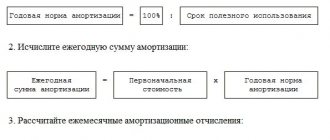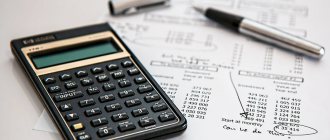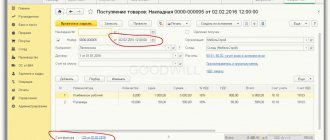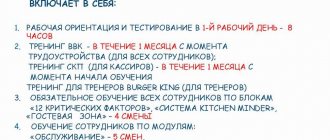What is account 20 “Main production” intended for?
To summarize the amounts of company expenses that are associated with the main activity, the 20th account (“Main production”) is used in accounting.
This refers to the costs incurred by the organization in the production process, when selling services or carrying out work. In the future, we will use the abbreviation TRU to designate goods, works and services. In accordance with the accounting rules, the debit of the 20th account collects direct costs incurred by the enterprise in the production of products, losses resulting from defects, expenses of auxiliary and service production. To the credit of this account, the cost of goods and services is written off.
For a list of costs that form the cost of production, see the tax guide from ConsultantPlus. Study the material by getting trial access to the K+ system for free.
A description of the 20th account, as well as an example of accounting for the expenses of an organization carrying out work for a customer, can be found in the material “Account 20 in accounting (nuances)”.
Let's consider the process of writing off the 20th account under various circumstances.
Easy: Take into account expenses without income
In accounting, expenses are shown in the period in which they occurred. Whether there is income or not is unimportant (clauses 17, 18 of PBU 10/99 “Expenses of the organization”). The order in which costs are reflected depends on the type of expense and the type of activity the company is engaged in.
So, if manufacturing firms temporarily have no income, but work continues, expenses are taken into account as usual. For example, amounts spent on the purchase of raw materials and supplies, to pay salaries to main employees, are debited to account 20 “Main production”. General business expenses are first taken into account on account 26, and then debited to account 20. Operating and non-operating expenses (clauses 11, 12 of PBU 10/99) are charged to account 91.2 “Other expenses”.
If the company is just preparing for work, then the costs should be taken into account in account 97 “Future expenses”. In the future, accumulated expenses are written off gradually (clause 19 of PBU 10/99). The write-off method must be established in the accounting policy. For example, uniform accounting over a certain period of time. Or proportional to any indicator, for example, the volume of production, revenue (clause 65 of the Regulations on accounting and financial reporting in the Russian Federation, approved by Order of the Ministry of Finance of July 29, 1998 No. 34n).
The situation with tax accounting is more complicated. There, expenses can be recognized only if they are aimed at generating income (Article 252 of the Tax Code). Let's look at the various situations a company can find itself in.
Stopover
The company suspends its work. There are various reasons: business repurposing, transition to a new type of product, financial difficulties, drop in demand or disruptions in the technological cycle. The stop may also be caused by reasons beyond the control of the company. Such a decision has the right to be made, for example, by the state labor inspectorate for violation of labor protection requirements (Article 25 of the Law “On the Fundamentals of Labor Safety in the Russian Federation” dated July 17, 1999 No. 181-FZ). Or a fire inspection (Article 6 of the Law “On Fire Safety” dated December 21, 1994 No. 69-FZ).
Officials allow expenses during the period of lack of income to be taken into account when calculating income tax. Condition: the activity must be aimed at generating income (letter of the Ministry of Taxation dated September 27, 2004 No. 02-5-11/162). That is, the company continues to operate and strives to earn income. The tax authorities do not explain how to confirm this.
The judges propose to “assess the costs of each taxpayer individually, based on the specific circumstances of financial and economic activity” (Resolution of the Federal Antimonopoly Service of the Central District dated August 17, 2004 No. A08-2355/04-21-16). The arbitrators explain that it is not the fact of receiving income in a particular tax period that is important, but the direction of expenses for generating income (resolution of the Federal Antimonopoly Service of the East Siberian District dated October 6, 2004 No. A19-2575/04-33-F02-4074/04- C1).
For example, lack of income may be due to the introduction of new technologies or business expansion. As a result of such actions, the company hopes to generate income in the future. Then the expenses associated with these areas are classified as other (subclause 34, clause 1, article 264 of the Tax Code) and are taken into account when calculating income tax. The Ministry of Finance also agrees with this position. In their letter dated July 10, 2003 No. 04-02-05/1/72, the specialists of this department assert that “the costs of preparing and developing new production facilities ... are fully included in the expenses of the current reporting (tax) period.”
There may be no income temporarily due to downtime. Downtime is a temporary suspension of work for reasons of an economic, technological, technical or organizational nature (Article 74 of the Labor Code). Losses associated with payment for downtime reduce profits regardless of who is to blame for the current situation (Resolution of the Presidium of the Supreme Arbitration Court of April 19, 2005 No. 13591/04). Losses due to a forced stop in work are classified as non-operating expenses (subclauses 3, 4, 6, clause 2, article 265 of the Tax Code). The amount of losses caused by downtime must be documented (letter of the Ministry of Finance dated January 16, 2006 No. 03-03-04/1/31).
"No income" period
A company may find itself in a situation where it operates, but for one reason or another does not receive revenue. This could last a month, or it could last a year. However, the company bears the costs. She has to, for example, pay rent and pay salaries.
Since the company’s activities are aimed at generating income, the company has the right to take into account expenses during the “non-income” period. But for this, the costs must comply with the conditions of Article 252 of the Tax Code. That is, to be economically justified and documented. And also have a monetary value.
If all these conditions are met, indirect (Article 318 of the Tax Code) and non-operating expenses (Article 265 of the Tax Code) reduce the base for calculating the profit of the current year (Article 315 of the Tax Code). If no profit is made during the year, then the loss is carried forward to the future (Article 283 of the Tax Code).
But direct costs need to be distributed between “unfinished”, unsold and sold products (Article 319 of the Tax Code). The company determines the list of direct costs independently in its accounting policy (clause 1 of Article 318 of the Tax Code). For example, these could be the costs of remunerating personnel involved in the production process, or the unified social tax accrued from their income. Direct expenses also include material costs, depreciation amounts of fixed assets that are used in production.
You can write off only those direct expenses that are associated with goods sold or services provided. This means that until the company sells anything, direct expenses cannot be written off when calculating income tax. They must be taken into account either as “work in progress” or as part of the finished product.
If the company fails to generate revenue, then the costs of such activities can be considered the costs of production that did not produce results.
Such expenses can be taken into account when calculating income tax as non-operating expenses (subclause 11, clause 1, article 265 of the Tax Code). In this case, the company must draw up an act. It must be approved by the director of the organization (Resolution of the Federal Antimonopoly Service of the Ural District dated April 4, 2005 No. F09-1126/05-AK).
We will refund VAT
The question of whether VAT can be offset on expenses if there is no income causes disputes between tax authorities and companies. In their letter, officials stated that “a tax deduction for VAT can be made no earlier than the reporting period when the tax base for value added tax arises,” that is, when the company begins to receive income (letter from the Moscow Department of Taxation and Tax Administration dated January 6, 2004 No. 24-11/00433). However, there is no such condition for VAT offset in the Tax Code (Articles 171, 172 of the Tax Code).
The established arbitration practice supports the position of taxpayers. The judges have repeatedly stated that the tax authorities’ reference “to the lack of sales in the disputed tax period cannot serve as a basis for refusing to apply tax deductions, since the presence of sales in the same period in which tax deductions are claimed is not a prerequisite for VAT reimbursement” ( resolution of the Federal Antimonopoly Service of the West Siberian District dated January 18, 2006 No. F04-9688/2005 (18696-A45-31), dated March 27, 2006 No. F04-1107/2006 (20510-A03-6), FAS Moscow District dated March 14, 2006 No. KA-A40/1484-06, FAS North-Western District dated February 26, 2006 No. A42-6232/2005).
The full text of the documents used can be found in SPS ConsultantPlus.
“Small” have their own accounting
Legislators allowed small firms to use the cash method of cost accounting (clause 20 of Order of the Ministry of Finance dated December 21, 1998 No. 64n “On standard accounting recommendations for small businesses”). It consists in the fact that only paid expenses are taken into account. In this case, it does not matter whether the company received income or not.
They have the status of a small enterprise. The number of employees is also important. For example, in industry, construction and transport, this figure should not exceed 100 people (Clause 1, Article 3 of Law No. 88-FZ of June 14, 1995 “On state support for small businesses in the Russian Federation”).
In tax accounting it is also possible to use the cash method. It is permitted for those organizations that “on average over the previous four quarters, the amount of revenue from the sale of goods (work, services) excluding value added tax did not exceed one million rubles for each quarter” (Clause 1, Article 273 of the Tax Code).
Do not forget that the method of accounting for expenses must be specified in the company's accounting policies.
Lilia IZOTOVA
Writing off costs from account 20 during production
In order to write off manufacturing expenses, the taxpayer must first select the method by which finished goods (FP) will be accounted for. The chosen method should then be approved in the text of the accounting policy (AP). Let us describe the possible methods from which an enterprise can choose.
In accordance with FSBU 5/2019 (until 2021 PBU 5/01), finished products are classified as that part of the inventory that is intended for sale. According to the standard, one of the following methods for assessing WTP should be used:
- At actual cost.
- Based on the amount of direct costs.
- Based on the amount of planned (standard) costs.
In this case, the first method is recommended to be used if we are talking about the production of goods in small batches, the second and third - in mass and batch production.
ConsultantPlus experts explained how to account for finished products according to the rules of the new FSBU 5/2019. Get free demo access to K+ and go to the Ready Solution to find out all the details of the innovations.
No idea what to do with expenses
1 2 3 4 5 6 7 8
Basis for writing off expenses in accountingI read it in the article “Accounting. Taxes. Law.” Question: Is it possible to take into account expenses if there are no expenses? (activities are not carried out). Answer of the Federal Tax Service of Russia - Expenses associated with the preparation and organization of activities can be taken into account when calculating the tax base in the period to which they relate. Date of recognition of expenses accrual method. However, you are not yet operating in the period in which these expenses can be recognized. Therefore, you do not reflect them on your tax return. When confirming receipt of income, you can take it into account for tax purposes. |
Enter the site
profit costs associated with its receipt. But in the period to which they belong. those. submit an updated declaration for the period in which these expenses arose. The organization is engaged in Construction and Installation Work (CEM). Direct 20 account - materials, salary. production..Indirect 26 account - License, software, stationery, salary. AUP.
clause 2 art.
318 of the Tax Code of the Russian Federation In this case, the amount of indirect costs for production and sales incurred in the reporting (tax) period is fully included in the expenses of the current reporting (tax) period, taking into account the requirements provided for by this Code. Non-operating expenses are included in the expenses of the current period in a similar manner. There are probably also non-operating expenses - banking services (cash and settlement services)
Direct expenses relate to expenses of the current reporting (tax) period as products, works, and services are sold, in the cost of which they are taken into account in accordance with Article 319 of this Code.
Art. 319 The procedure for assessing balances of work in progress, balances of finished products, goods shipped, it turns out that no, in any case, in accordance with the Tax Code of the Russian Federation, you must take into account indirect and non-operating expenses in the current reporting period.
After all, if we consider a similar situation with VAT. There is no revenue, the deduction has been accrued (the activity has just begun). I think it would be wiser not to submit a declaration with a VAT refund from the budget, but to wait for the proceeds, an advance payment according to the calculation. account. And the same with income tax.
As for accounting, in 9 months I have not even received materials for installation, while only contract agreements have been concluded. Therefore, there is no work in progress, account 20 balance is “0”.
And what also confuses me is that they say the costs should be written off to account 97, and then written off, but I immediately wrote them off from account 20 to 90. I don’t know, maybe I’m wrong.
There are expenses, but no revenue
This situation is often encountered by companies with seasonal activities. However, ordinary enterprises also sometimes experience a temporary lull in sales. What then should you do with expenses that cannot be avoided?
“The costs you listed are indirect. Such expenses must be collected on account 26 “General business expenses”. They can be written off only when the company receives income. If there is no income, then indirect expenses are taken into account in account 97 “Deferred expenses”.
Indirect costs are not directly related to the production of products. They include administrative and commercial expenses.
“Prepaid expenses can be written off in two ways. Firstly, you can include them in expenses completely at the moment when your company begins to rent out equipment. Another option is to spread it over several periods. The chosen option must be reflected in the director’s order.”
“How to correctly reflect expenses in tax accounting if the company does not receive income?”
“It depends on what method you use to calculate profits. Our company, for example, uses the cash method. We take into account expenses in the period when they were paid (Article 273 of the Tax Code of the Russian Federation). It does not matter whether the organization received income or not.
Expenses incurred are simply written off as a loss. For profit tax purposes, losses of the reporting year and previous years are allowed to be carried forward for a period of no more than ten years. That is, the tax base in the new year can be reduced by all or part of the amount of the loss.
The rules for carrying forward losses are described in Article 283 of the Tax Code.”
If the company uses the accrual method, then all expenses are divided into:
- costs associated with production and sales;
- non-operating expenses.
Non-operating expenses reduce taxable income in the period in which they are incurred. The order in which they are written off does not depend on whether the company has income or not.
Source: https://bookerlife.ru/net-realizacii-kuda-devat-rashody/
Write-off of costs at actual cost
Having organized the accounting of GPs at actual cost, the accountant in charge of production must make the following entry: Dt 43 Kt 20.
The essence of this entry is that the cost price is written off directly and in the actual amount generated from the account that records expenses to the account in which GP records are kept.
Despite the simplicity and attractiveness of this method, there are limitations in its use. The point is that the actual cost can only be calculated at the end of the reporting period. In circumstances where products are shipped continuously, it is better to take the planned cost as a basis.
There are 2 options for organizing accounting: write off expenses using account 40 ( “ Release of finished products”), or do without it.
Write-off of expenses in the absence of revenue
Write-off of general business expenses in accounting and tax accounting if there was no sales revenue in the corresponding reporting (tax) period.
In accounting, expenses are recognized in the reporting period in which they occurred, regardless of the time of actual payment. Expenses are subject to recognition regardless of the intention to receive revenue and the form of expenditure (cash, in kind and other) (clauses 17, 18 of the Accounting Regulations “Expenses of the Organization” PBU 10/99).
Thus, the recognition of expenses in accounting does not depend on the presence (absence) of sales revenue in the corresponding reporting period. The accumulation of general business expenses in account 97 “Deferred expenses” and subsequent write-off in the reporting period in which the sales proceeds will be received contradicts the basic principles of accounting1:
— the requirement of timeliness ( timely reflection of the facts of economic activity in accounting and financial statements); — the requirement of prudence (greater readiness to recognize expenses and liabilities in accounting than possible income and assets, avoiding the creation of hidden reserves ).
Consequently, the accumulation of general business expenses on account 97 leads to a distortion of the organization’s financial results for the reporting period and the formation of unreliable financial statements.
Depending on the chosen method, management expenses accounted for on account 26 “General business expenses” are included either in the cost of products (works, services), or directly - in the cost of sales of the reporting period in which they arose (clause 9 of PBU 10/99, Plan accounting accounts2).
When choosing the first accounting option, management costs are distributed among costing objects. Then (in the absence of sales) part of the administrative expenses can be taken into account in the balances of work in progress.
If the second accounting option is chosen, then the organization can monthly write off administrative expenses as a debit to account 90 in full, even in the absence of its credit turnover.
In our opinion, the complete write-off of management expenses from the credit of account 26 to the debit of account 90 in the absence of revenue is fair for situations where, in general, the organization’s economic activities are carried out, but in some reporting periods there were no sales.
However, it is necessary to take into account the following circumstance.
In accordance with paragraph 4 of PBU 10/99, the division of an organization’s expenses into expenses for ordinary activities and other expenses depends on their nature, conditions of implementation and areas of activity of the organization. As a rule, administrative expenses are expenses from ordinary activities (clauses 5, 7 of PBU 10/99). If the economic activity of an organization is actually suspended, then management expenses lose their status as expenses for ordinary activities.
Expenses other than expenses for ordinary activities are considered other expenses. Therefore, in such a situation, the inclusion of administrative expenses in other expenses (writing off account 91-2 as a debit) will be justified. This procedure for accounting for management expenses should be enshrined in the accounting policy of the organization (clause 7 of PBU 1/2008).
In tax accounting, general business expenses incurred that meet the criteria of paragraph 1 of Art. 252 of the Tax Code of the Russian Federation, relate to indirect expenses and are recognized in the reporting period in which they were incurred (paragraphs 7, 8, 9, paragraph 1, paragraph 2, Article 318, paragraph 1, Article 272 of the Tax Code of the Russian Federation).
If during the period of recognition of general business expenses the organization did not have both income from sales and non-operating income, then a loss will be formed in tax accounting - a negative difference between income and expenses taken into account in the manner determined by Chapter 25 of the Tax Code of the Russian Federation. Accordingly, in this reporting (tax) period, the tax base for income tax is recognized as equal to zero (paragraph 1, clause 8, article 274 of the Tax Code of the Russian Federation).
The resulting loss is accepted for profit tax purposes in the following reporting (tax) periods in the manner and under the conditions established by Art. 283 of the Tax Code of the Russian Federation (paragraph 2, clause 8, article 274 of the Tax Code of the Russian Federation).
1 clause 6 of the Accounting Regulations “Accounting Policy of the Organization” PBU 1/2008, approved. By Order of the Ministry of Finance of the Russian Federation dated October 6, 2008 No. 106n, hereinafter referred to as PBU 1/2008..
2. Approved By Order of the Ministry of Finance of the Russian Federation of October 31, 2000 No. 94n.
Write-off of costs at planned cost through account 40
If the 40th account is used, then the entire difference between the actual and planned cost amounts appears here.
The debit of the 40th account reflects the actual generated cost of the GP: Dt 40 Kt 20.
On the credit of this account, the cost calculated according to the standards is written off: Dt 43 Kt 40.
At the end of the month, a balance may form on the 40th account, which is nothing more than the difference between the actual and planned cost. Using the resulting amount, the cost of sales is adjusted on the 90th account:
- if the actual indicator is greater than the planned one, an entry is made: Dt 90.2 Kt 40;
- if the planned indicator turns out to be more than the actual one - reversal Dt 90.2 Kt 40.
Check whether you are accounting for production costs correctly using the Typical Situation from ConsultantPlus. If you do not have access to the K+ system, get a trial online access for free.
Expenses without income: will there be problems? What to do with expenses if there is no income
It often happens that an organization has been created* and carries out some expenses (calculation of wages, servicing bank accounts, etc.
), but at the same time for a certain time, for various reasons, has no income from sales of products, works and services. There is no direct answer to the question of how to take such expenses into account in accounting.
In the proposed article by V.V. Patrov, Doctor of Economics, Prof. St. Petersburg State University, expresses its point of view on this issue.
It includes the ability to bring up certain parameters from the previous year to define concepts and combine them into accounts. In this case, we associate accounts corresponding to each of the concepts that make up the formats that will be presented. The worksheet allows you to check, view, create and change all the information to generate files.
Formats wages and salaries compensation
Consultation on the selection of personnel in accordance with various user-defined criteria, such as academic level, length of service in positions, city of residence, languages spoken or written, personalized characteristics of interviewers and others.
This makes it possible to establish the consultation of the employee's beneficiaries, the illnesses that suffer, the bodies with which they retire with possible layoffs, and refer to both acquaintances and labor. Personalization of employee characteristics such as skin color, specific brands, gender, height, completely defined by users.
Consultations and reports on human resources in which the user can customize according to their needs queries such as: personnel selection with various criteria, CV and characteristics queries, family and beneficiary management, children and age control, birthday of the month list among others .
Choice of several types of settlements, such as: periodic, vacation, dismissal, final, collective vacation, collective release, self-assessment of contributions. Information is taken directly from the parameter capture with the ability to include new items in any of the employees.
Management of paid non-paid unpaid activities such as holidays or holidays, maternity leave, general illness, occupational hazards, control of permit resolution and inclusion of reason for inactivity.
This allows for programmed discounts per employee on various concepts such as loans, employee fund savings or co-op agreements. Formation of account flat file format including movement of accounts and third parties.
Service named status requests in which the user can have a single and common cost of payments of their employees, including provisions. Includes a billing module that allows you to parameterize and customize the invoice format by the user. Control over salary increases, compliance with retroactive and maximum restrictions.
Human Resource Consulting, Employees, Localities, Consolidated, Self Assessment, Credit Control, Inactivity History, New, Final among many others. All reports in this module can be sent on screen, on magnetic media, or directly to a printer using print properties processing.
Special tools that can help you import resumes, personal income, news, savings, etc.
- Personnel management from the interview process to the recruitment and selection process.
- Create a flat batch file for payment in banks or corporations.
A completely web-based product focused on human talent management.
Note:
* According to paragraph 2 of Article 51 of the Civil Code of the Russian Federation legal. a person is considered created from the moment of its state registration, i.e. entry into the Unified State Register of Legal Entities (author's note).
Accounting for expenses will mainly depend on what the organization does (production, performance of work, provision of services, trade, etc.).
Some billing reports
Identification of the buyer when making cash sales, which does not require them to be officially included in the customer list, but if they have their identity. It sets and obeys the restrictions for negotiations with stops recorded during the preparation of the operator profile.
Daily Sales Tax Report, Summary Billing Movement, Detailed Billing Movement, Group Billing Ratio. Return on sales by item. Questions and answers made on invoices. Coordination with other modules. It pauses an operation that needs to be completed in a later process.
Subsequently, invoicing processes are taken individually or in groups to complete the circle of the sales and accounting process.
Some referral reports
- Updates the Daily Sales Tax Report workbook.
- List of items included in invoices.
- List of services included in invoices.
- Consistent control of invoices.
- Return on sales by product group.
- Develop a referral, it is based on and follows the same principles of the account.
- Here the client is identified and the goods are unloaded.
- Monitor sufficiently that no remissions are removed.
Daily sales tax report, Summary of final payment, Detailed billing movement, Billing relationship by group, List of items included in invoices, List of services included in invoices, Control of sequential invoices.
Debit 20 (analytical accounts by type of product) Credit 25
Indirect expenses collected in account 26 are also completely written off from this account at the end of the month. However, unlike expenses of the first group, they can be written off in two ways.
The first method (traditional) is similar to writing off expenses recorded on account 25 (the distribution base is also selected), account 20 is debited (analytical accounts by type of product) and account 26 is credited.
Source: https://www.small-businessrf.ru/rent/expenses-without-income-will-there-be-problems-what-to-do-with-expenses-if-there-is-no-revenue. html
Write-off of costs at planned cost without using account 40
This method of accounting implies that the planned cost should be reflected on the 43rd account immediately after the GP is entered into the incoming documents: Dt 43 Kt 20.
When the GP is shipped, the same amount is reflected on the 90th account: Dt 90.2 Kt 43.
As soon as the reporting period ends, the actual cost of the GP and the difference in the actual and planned cost indicators will appear on the 20th account. You will need to make adjustments to account 43 for the amount received:
- upward, if the actual indicator is greater than the planned one, with the following entry: Dt 43 Kt 20.
- downward if the planned indicator turns out to be greater than the actual one: reversal Dt 43 Kt 20.
You can learn more about accounting for SOEs from the material “How are finished products reflected in the balance sheet?”
Other operations affecting the credit of the 20th account
Here are a few more situations when the 20th account credit entry is used:
- A company engaged in the sale of services or production of work writes off the expenses collected on the 20th account to the sales account as soon as the customer has accepted the results. To reflect revenue and write off costs, the following entries are made:
- Dt 62 Kt 90.1;
- Dt 90.3 “VAT on sales” Kt 68;
- Dt 90.2 Kt 20.
- If a company uses its own products for its own purposes, the entry will look like this: Dt 10 “Materials” Kt 20.
- Large industries with large volumes of output prefer to account for semi-finished products produced by themselves in a separate account. The posting of such materials must be accompanied by the following entry: Dt 21 “Semi-finished products of own production” Kt 20.
- When recording defective products, the corresponding amounts are reflected as follows: Dt 28 “Defects in production” Kt 20.
- If a shortage is identified during the inventory process of the main production, the following entry is made: Dt 94 “Shortages and losses from damage to valuables” Kt 20.
- When terminating a contract under which products have already been produced, expenses are incurred, reflected as follows: Dt 91.2 “Other expenses” Kt 20.
There are expenses, but no revenue: what should an accountant do?
It often happens that an organization is created*, carries out some expenses (calculation of wages, servicing bank accounts, etc.), but for a certain time, for various reasons, has no income from sales of products, works and services.
There is no direct answer to the question of how to take such expenses into account in accounting. In the proposed article by V.V. Patrov, Doctor of Economics, Prof. St. Petersburg State University, expresses its point of view on this issue.
Note:
* According to paragraph 2 of Article 51 of the Civil Code of the Russian Federation legal.
a person is considered created from the moment of its state registration, i.e. entry into the Unified State Register of Legal Entities (author's note).
Accounting for expenses will mainly depend on what the organization does (production, performance of work, provision of services, trade, etc.).
Accounting for costs associated with production of products
Let's consider the cost accounting methodology using the example of an ordinary product manufacturing enterprise that does not have auxiliary and service industries.
All costs associated with production are divided into two types: direct and indirect.
Direct expenses are those that can be immediately attributed to some type of product* (salary of a worker engaged in the production of one type of product; consumption of materials for a specific type of product, etc.).
Note:
* Cost accounting separately for each type of product is necessary for cost calculation, i.e. calculating costs per unit of production.
Indirect expenses are those that cannot be immediately attributed to any type of product (chief accountant’s salary, telephone subscription fee, office expenses, etc.).
Direct expenses during the month are immediately written down to the debit of account 20 “Main production” (to the corresponding analytical accounts by type of product) with crediting to accounts for materials accounting, settlements with personnel for wages, etc.
Indirect costs are divided into two groups:
- Maintenance of main production.
- For management needs not directly related to the production process.
Indirect expenses of the first group during the month are reflected in the debit of account 25 “General production expenses”, and of the second group - in the debit of account 26 “General business expenses”. At the same time, accounts for accounting for materials, settlements with personnel for wages, etc. are also credited.
At the end of the month, indirect costs collected on account 25 are distributed between types of products produced in proportion to some base (the sum of direct costs, wages of production workers, equipment operating time, etc.). The distribution base is determined by the organization itself and is recorded in the accounting policy order.
After distribution to the total amount of expenses collected on account 25, an entry is made:
Debit 20 (analytical accounts by type of product) Credit 25
Indirect expenses collected in account 26 are also completely written off from this account at the end of the month. However, unlike expenses of the first group, they can be written off in two ways.
The first method (traditional) is similar to writing off expenses recorded on account 25 (the distribution base is also selected), account 20 is debited (analytical accounts by type of product) and account 26 is credited.
The second method is based on the premise that general business expenses do not have a direct connection with the production process, are conditionally constant, and, as a result, are reflected in full on the financial results of the reporting period. In other words, they are written off without any distribution by type of product by posting:
Debit 90 “Sales” Credit 26 “General expenses”
The method of writing off general business expenses is chosen by the organization itself and is recorded in its accounting policies.
The result of the work of most manufacturing enterprises is the production of finished products, which are delivered to the warehouse. This records the following:
Debit 43 “Finished products” or 40 “Release of products (works, services)”* Credit 20 “Main production”
Note:
* The use of accounts 43 or 40 is determined by the accounting policy of the organization
After this entry, the balance of account 20 represents the amount of costs related to products that have not gone through all stages of the production cycle (work in progress).
As soon as the finished product (or part of the product) is sold, the expenses related to this product are written off by posting:
Debit 90/2 “Cost of sales” Credit 43 “Finished products”
Before sales begin (before revenue appears), the organization's expenses are listed in accounts 20 (related to work in progress) and 43 (related to products released but not sold, stored in the warehouse).
When compiling the balance sheet, the balance of these accounts is reflected respectively in the articles “Costs in work in progress” (indicator code 213) and “Finished products and goods for resale” (indicator code 214).
Based on the foregoing, in the absence of revenue from the sale of products (goods, works, services), the section “Income and expenses from ordinary activities” of the profit and loss statement is not filled out.
If, according to the accounting policy, general business expenses collected on account 26 are written off to the debit of account 90, this write-off is not carried out until the organization has revenue.
Some experts believe that choosing in the accounting policy the option of writing off expenses from account 26 to the debit of account 90 means recognizing these expenses as conditionally fixed. Conditionally fixed expenses are expenses that should reduce the financial result of the reporting period in which they were incurred.
The presence of these expenses is in no way related to the volume of production and/or the fact of its sale. It follows from this that, in accordance with the assumption of temporary certainty of the facts of economic activity (clause
6 PBU 1/98) if there is no revenue from the sale of products in a specific period, the amounts of such expenses reflected in account 26 should be written off as a decrease in the profit of the current reporting period by recording:
Debit account 91 “Other income and expenses” subaccount 2 “Other expenses” Credit account 26 “General business expenses”
From account 91-2, the amount of these expenses is written off to account 99 “Profits and losses”. As a result, the amount of these expenses will be shown in the balance sheet and in the income statement as a loss on operating activities.
We believe that the amount of such a loss should be determined taking into account all income and expenses from ordinary activities, and not just semi-fixed expenses. Nevertheless, the above point of view has a right to exist, and each organization must choose its own option for writing off general business expenses, enshrining it in its accounting policy.
In our opinion, when drawing up a balance sheet, the amount of these general business expenses, recorded on account 26, is added (without posting) to the balance of account 20 and shown under the item “Costs in work in progress.”
When revenue is subsequently received, these expenses, depending on the accounting policy, are written off to the debit of account 90 either immediately in full or in parts over several reporting periods (in proportion to the volume of products sold in the total volume of its output at the time the revenue begins to be received).
Cost accounting when performing work, providing services, trading activities
Account 20 “Main production” is also used to account for expenses associated not only with the production of products, but also with the performance of work and the provision of services.
At the same time, in accordance with the Instructions for the use of the Chart of Accounts, “Organizations whose activities are not related to the production process (commission agents, agents, brokers, dealers, etc., except for organizations engaged in trading activities), use account 26 “General business expenses” for generalization of information on the costs of conducting this activity.”
To account for expenses associated with trading activities, organizations use account 44 “Sales expenses”. In these cases, in the absence of revenue, the balance of accounts 26 and 44 should, in our opinion, be reflected in the balance sheet under the item “Other inventories and costs” (indicator code 217).
In these organizations, accounting for expenses on accounts 20 and 26 is similar to the accounting procedure in organizations engaged in production, given above.
Cost accounting of auxiliary and service production
Some organizations, in addition to their main production, have auxiliary production (repair of fixed assets, production of various types of energy, transport services, etc.) and/or service industries and facilities (housing and communal services, catering establishments, preschool institutions, holiday homes, etc. .).
In these industries and farms, the functions of account 20 “Main production” are performed by accounts 23 “Auxiliary production” and 29 “Service production and farms”, respectively.
The costs recorded in the debit of these accounts are subsequently written off to the accounts for accounting for the costs of those divisions of the organization that consume the services of the above-mentioned industries and farms (20, 25, 26, etc.), as well as to the accounts for accounting for inventories and finished products produced auxiliary industries, as well as service industries and farms (10, 43, etc.).
The balances of accounts 23 and 29 show the balances of unfinished auxiliary and servicing production, respectively.
Other income and expenses
Even in the absence of revenue from the sale of products (goods, works and services), organizations may have other income and expenses in the form of other income and other expenses.
Other income includes operating, non-operating and extraordinary income. Other expenses include operating, non-operating and extraordinary expenses. The procedure for recognizing other income and other expenses is disclosed in sections IV, respectively, PBU 9/99 “Income of the organization” and PBU 10/99 “Expenses of the organization.”
Operating and non-operating income and expenses are recorded on account 91 “Other income and expenses”, and extraordinary income and expenses on account 99 “Profits and losses”.
These income and expenses should always (even in the absence of revenue from the sale of products, goods, works and services) be reflected in the corresponding indicators of the profit and loss statement.
A positive difference between other income and other expenses will represent profit before tax, and a negative difference will represent loss before tax.
Source: https://buh.ru/articles/documents/13755/
Account balance 20 “Main production”
At the end of the reporting period, the organization identifies and writes off the cost of production on account 20 “Main production”. As a result of these activities, a debit balance may be formed. This indicator reflects how high the cost of the work in progress is. The resulting amount on the 20th account should be transferred to the next month.
How to properly organize accounting of work in progress and how its indicators are entered into the balance sheet, you can learn from the material “Main production in the balance sheet (nuances).”
Results
The credit of the 20th account shows the cost of the finished product, whether it is intended for sale or for one’s own needs, the cost of services sold, work performed.
This amount is transferred to the 40th, 43rd, 90th or other account, as required by the accounting policy of the enterprise and the nature of the transaction performed. You can find more complete information on the topic in ConsultantPlus. Free trial access to the system for 2 days.








